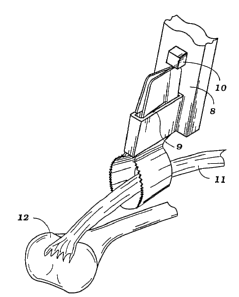Some of the information on this Web page has been provided by external sources. The Government of Canada is not responsible for the accuracy, reliability or currency of the information supplied by external sources. Users wishing to rely upon this information should consult directly with the source of the information. Content provided by external sources is not subject to official languages, privacy and accessibility requirements.
Any discrepancies in the text and image of the Claims and Abstract are due to differing posting times. Text of the Claims and Abstract are posted:
| (12) Patent: | (11) CA 2196413 |
|---|---|
| (54) English Title: | SPLIT STEM SURGICAL SAW BLADE |
| (54) French Title: | LAME DE SCIE CHIRURGICALE COMPORTANT UNE TIGE FENDUE |
| Status: | Deemed expired |
| (51) International Patent Classification (IPC): |
|
|---|---|
| (72) Inventors : |
|
| (73) Owners : |
|
| (71) Applicants : |
|
| (74) Agent: | RIDOUT & MAYBEE LLP |
| (74) Associate agent: | |
| (45) Issued: | 2006-03-21 |
| (86) PCT Filing Date: | 1995-07-31 |
| (87) Open to Public Inspection: | 1996-02-22 |
| Examination requested: | 2002-07-10 |
| Availability of licence: | N/A |
| (25) Language of filing: | English |
| Patent Cooperation Treaty (PCT): | Yes |
|---|---|
| (86) PCT Filing Number: | PCT/US1995/009616 |
| (87) International Publication Number: | WO1996/004855 |
| (85) National Entry: | 1997-01-30 |
| (30) Application Priority Data: | ||||||
|---|---|---|---|---|---|---|
|
This invention is a bone plug cutting blade (3) for a
peripheral drive oscillating surgical saw. The blade (3) has
a split stem (1, 2) so that it can be placed around a tendon
(11) attached to the bone (12) before being inserted into
the saw blade holder (8).
L'invention concerne une lame (3) de scie chirurgicale oscillante à moteur périphérique, servant à découper un bouchon osseux. Cette lame (3) possède une tige fendue (1)(2), ce qui permet de la placer autour d'un tendon (11) attaché à l'os (12) avant de l'introduire dans le support de lame de la scie.
Note: Claims are shown in the official language in which they were submitted.
Note: Descriptions are shown in the official language in which they were submitted.

For a clearer understanding of the status of the application/patent presented on this page, the site Disclaimer , as well as the definitions for Patent , Administrative Status , Maintenance Fee and Payment History should be consulted.
| Title | Date |
|---|---|
| Forecasted Issue Date | 2006-03-21 |
| (86) PCT Filing Date | 1995-07-31 |
| (87) PCT Publication Date | 1996-02-22 |
| (85) National Entry | 1997-01-30 |
| Examination Requested | 2002-07-10 |
| (45) Issued | 2006-03-21 |
| Deemed Expired | 2007-07-31 |
There is no abandonment history.
| Fee Type | Anniversary Year | Due Date | Amount Paid | Paid Date |
|---|---|---|---|---|
| Application Fee | $0.00 | 1997-01-30 | ||
| Maintenance Fee - Application - New Act | 2 | 1997-07-31 | $50.00 | 1997-07-22 |
| Maintenance Fee - Application - New Act | 3 | 1998-07-31 | $50.00 | 1998-07-30 |
| Maintenance Fee - Application - New Act | 4 | 1999-08-03 | $50.00 | 1999-07-23 |
| Maintenance Fee - Application - New Act | 5 | 2000-07-31 | $75.00 | 2000-07-18 |
| Maintenance Fee - Application - New Act | 6 | 2001-07-31 | $75.00 | 2001-07-20 |
| Request for Examination | $200.00 | 2002-07-10 | ||
| Maintenance Fee - Application - New Act | 7 | 2002-07-31 | $75.00 | 2002-07-11 |
| Maintenance Fee - Application - New Act | 8 | 2003-07-31 | $75.00 | 2003-07-23 |
| Maintenance Fee - Application - New Act | 9 | 2004-08-02 | $100.00 | 2004-04-28 |
| Maintenance Fee - Application - New Act | 10 | 2005-08-01 | $125.00 | 2005-04-20 |
| Final Fee | $150.00 | 2006-01-03 |
Note: Records showing the ownership history in alphabetical order.
| Current Owners on Record |
|---|
| MCLEES, DONALD J. |
| Past Owners on Record |
|---|
| None |